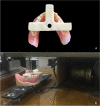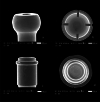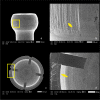Quantitative and qualitative assessment of the wear pattern of two attachment systems of dissimilar materials for mandibular implant-retained overdentures: an in-vitro study
- PMID: 38036982
- PMCID: PMC10687975
- DOI: 10.1186/s12903-023-03693-6
Quantitative and qualitative assessment of the wear pattern of two attachment systems of dissimilar materials for mandibular implant-retained overdentures: an in-vitro study
Abstract
Background: Attachment material is one of the contributing factors to the degree of wear of the attachment components in mandibular implant-retained overdentures. The purpose of this in vitro study was to compare the wear behavior of 2 different attachment systems of dissimilar materials in mandibular implant-retained overdentures by qualitative and quantitative methods.
Methods: Two attachment systems of different materials were utilized (n = 16); Titach (Dental Evolutions Inc, Beverly Hills, CA, USA) with a titanium-to-titanium interface and Locator R-Tx (Zest Anchors Inc, Escondido, CA, USA) with a titanium-to-nylon interface. One thousand cycles of overdenture insertion and removal simulating 1-year clinical use were performed. All matrices were removed from the overdentures and all patrices were unscrewed from the implants for wear assessment quantitively using a stereomicroscope and qualitatively using a scanning electron microscope. Data were analyzed by using an independent sample t test.
Results: After cyclic loading, stereomicroscopic findings showed that the Titach group had statistically significant higher wear value than the Locator R-Tx group (p < 0.001). Moreover, scanning electron microscopy images showed noticeable abrasion in Titach patrix at the area of highest convexity. However, the Locator R-Tx matrix displayed an apparent tear of rubber inserts.
Conclusions: Titach attachment with the titanium-to-titanium interface revealed more wear than Locator R-Tx attachment with the titanium-to-nylon interface. Thus, the type of attachment material influences the degree of wear of the attachment components.
Keywords: Attachment wear; Implant-assisted overdenture; Locator R-Tx attachment; Titach attachment; Titanium-to-nylon interface; Titanium-to-titanium interface.
© 2023. The Author(s).
Conflict of interest statement
The authors declare no competing interests.
Figures








References
-
- Mahanna FF, Elsyad MA, Mourad SI, Abozaed HW. Satisfaction and Oral Health-Related Quality of Life of Different Attachments Used for Implant-Retained Overdentures in Subjects with Resorbed Mandibles: A Crossover Trial. Int J Oral Maxillofac Implants. 2020;35(2):423–431. doi: 10.11607/jomi.7869. - DOI - PubMed
-
- Emami E, Heydecke G, Rompré PH, de Grandmont P, Feine JS. Impact of implant support for mandibular dentures on satisfaction, oral and general health-related quality of life: a meta-analysis of randomized-controlled trials. Clin Oral Implants Res. 2009;20(6):533–544. doi: 10.1111/j.1600-0501.2008.01693.x. - DOI - PubMed
-
- Feine JS, Carlsson GE, Awad MA, Chehade A, Duncan WJ, Gizani S, et al. The McGill consensus statement on overdentures: mandibular two-implant overdentures as first choice standard of care for edentulous patients. Int J Oral Maxillofac Implants. 2002;17(4):601–602. - PubMed
Publication types
MeSH terms
Substances
LinkOut - more resources
Full Text Sources

